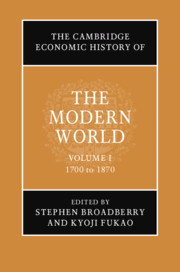Book contents
- The Cambridge Economic History of the Modern World
- The Cambridge Economic History of the Modern World
- The Cambridge Economic History of the Modern World
- Copyright page
- Contents
- Figures
- Tables
- Contributors to Volume I
- Preface and Acknowledgements
- Introduction to Volume I
- Part I Regional Developments
- 1 Britain, the Industrial Revolution, and Modern Economic Growth
- 2 Continental Europe
- 3 Tokugawa Japan and the Foundations of Modern Economic Growth in Asia
- 4 China: The Start of the Great Divergence
- 5 From the Mughals to the Raj: India 1700–1858
- 6 Sustainable Development in South East Asia
- 7 The Ottoman Empire, 1700–1870
- 8 The Economic History of North America, 1700–1870
- 9 Latin America: 1700–1870
- 10 Africa: Slavery and the World Economy, 1700–1870
- 11 Australia: Geography and Institutions
- Part II Factors Governing Differential Outcomes in the Global Economy
- Index
- References
7 - The Ottoman Empire, 1700–1870
from Part I - Regional Developments
Published online by Cambridge University Press: 03 June 2021
- The Cambridge Economic History of the Modern World
- The Cambridge Economic History of the Modern World
- The Cambridge Economic History of the Modern World
- Copyright page
- Contents
- Figures
- Tables
- Contributors to Volume I
- Preface and Acknowledgements
- Introduction to Volume I
- Part I Regional Developments
- 1 Britain, the Industrial Revolution, and Modern Economic Growth
- 2 Continental Europe
- 3 Tokugawa Japan and the Foundations of Modern Economic Growth in Asia
- 4 China: The Start of the Great Divergence
- 5 From the Mughals to the Raj: India 1700–1858
- 6 Sustainable Development in South East Asia
- 7 The Ottoman Empire, 1700–1870
- 8 The Economic History of North America, 1700–1870
- 9 Latin America: 1700–1870
- 10 Africa: Slavery and the World Economy, 1700–1870
- 11 Australia: Geography and Institutions
- Part II Factors Governing Differential Outcomes in the Global Economy
- Index
- References
Summary
There were two very different conjunctures for the Ottoman economy during the eighteenth century. The decades until the end of the 1760s were a period of relative peace and economic expansion. In contrast, from the end of the 1760s until the 1820s was a period of wars and domestic political struggles when long-distance trade as well as agricultural and manufacturing output were frequently disrupted, state finances came under pressure and the frequent debasements led to inflation. Even though trade and more generally economic interaction between the Ottoman Empire and western Europe increased during the eighteenth century, its volume remained small. As a result, both urban and rural crafts and manufacturing activities in the Ottoman Empire remained mostly intact. The nineteenth century was a period quite different from the earlier era. It was characterized, on the one hand, by major efforts of Western-style reform in administration, education, law, and justice, as well as economic, fiscal, and monetary affairs. It was also a period of integration into world markets and rapid expansion in trade with industrial Europe that transformed the Ottoman economy into an exporter of primary products and importer of manufactures.
Keywords
- Type
- Chapter
- Information
- The Cambridge Economic History of the Modern World , pp. 169 - 192Publisher: Cambridge University PressPrint publication year: 2021

